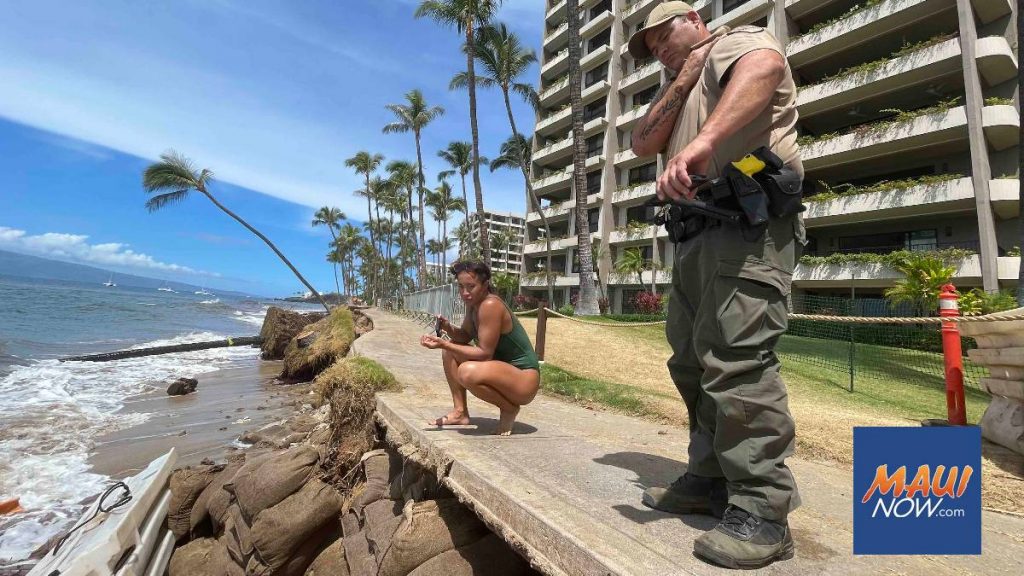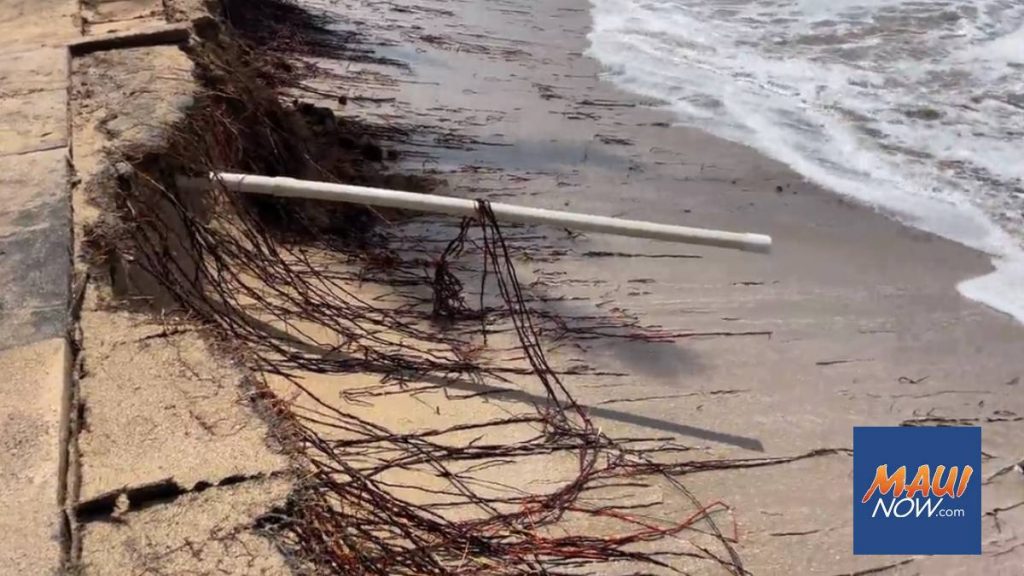Popular Maui beachwalk, trees fall into ocean, triggering calls for managed retreat

Popular Kāʻanapali Beach was a far cry from paradise on Friday.
A concrete section of Kāʻanapali Beachwalk was crumbling into the ocean, tall coconut trees crashed in the high surf and a stretch of walkway pooled with minor flooding and debris.
Beach access was cut off and pedestrians were rerouted fronting Kāʻanapali Aliʻi Resort, where damage from surf-induced erosion is the worst.
“How much is that going to cost?” one visitor asked a hotel official about the missing sidewalk.
“Oh, that’s too bad,” another tourist added, stepping on undermined areas to get pictures.
Intensifying erosion after big south swells is why local activists are pushing for change along Kāʻanapali, one of Maui’s most coveted coastlines.
While erosion events are toppling single-family homes and damaging coastal properties around the state, this West Maui swath is lined by at least seven hotels and resort condos and has been struck with episodic and chronic erosion for about four decades.
Most mitigation measures just make things worse, and the buildings need a plan for “aggressive” managed retreat, according to shoreline advocates Kai Nishiki and Tiare Lawrence, Native Hawaiians with West Maui ties.
“The tourism industry has made billions of dollars off our beaches, reefs and pristine waters and now their actions are destroying it all,” Nishiki said. “It would be great for all concerned — the community, the resorts, environmental organizations, Hawaii Tourism Authority, UH Sea Grant, the state and the county to begin adaptation pathways exercises and immediately secure funding for planning, design and execution of an aggressive managed retreat plan, sand dune restoration and vegetation management plan.”
Hotel officials and the state were mum about any immediate plans, though.

A state Department of Land and Natural Resources Division of Conservation and Resources Enforcement officer investigated the area Friday.
When asked whether water quality is being impacted by damaged infrastructure or if shoreline mitigation rules are being followed by landowners, the department chose not to respond.
“Maui DOCARE is working with the Office of Conservation and Coastal Lands with checking the status of the known, on-going coastal erosion concerns in the Ka’anapali area,” a DLNR spokesperson told Maui Now via email. “As this situation remains under review, we will have no further comment.”

Kāʻanapali Aliʻi hotel official Channing Bridges said the main priority right now is public safety.
“It’s a new challenge,” said Bridges, Kāʻanapali Aliʻi director of owner experience. “This is not something you can plan in advance for. I think the number one concern right now is keeping people safe. As you can see, it’s not safe conditions. We have people routed around.”
In response to questions by Nishiki, Fred Torres, Kāʻanapali Aliʻi hotel operations manager, said that all rules are being followed. Before any erosion mitigation measures can be implemented, landowners must obtain state and sometimes county permits.
The hotel leaders said they’re consulting with private engineers and government officials about what to do next.
“I don’t even know if we will be allowed to repair the sidewalks,” Bridges said. “We have to get a special permit. Whether they grant that or not, who knows.”
Since a large south swell hit in July, several portions of the Kāʻanapali Beachwalk have been compromised and sectioned off with signs and barriers. On Monday, Kāʻanapali Aliʻi began rerouting pedestrians due to trees falling and the sidewalk cracking.
Another south swell toward the end of this week exposed broken plastic irrigation, debris of all kinds, massive amounts of dirt fill, along with grass, trees, shrubs, roots and root balls. The mess is causing huge sediment plumes in the nearshore waters, likely smothering and damaging the reef, Nishiki said.

Privately owned and maintained Kāʻanapali Beachwalk stretches more than three miles from the Hyatt Regency Maui in the south to the Honua Kai Resort in the north, according to a state report. Studies of the entire walkway system documented 18,000 pedestrian trips per day, totaling roughly 6,570,000 pedestrian trips per year.
The beachwalk and other areas of Kāʻanapali have suffered damage over decades, dating back to the late 1990s when a north swell severely impacted the north end of the beach. The beachwalk fronting the Sheraton was undermined, and the pool facility was threatened. As a result, road plates were driven into the sand to protect the facility.
An erosion event in 2003 at Hanakaʻōʻō Point resulted in the loss of up to 30 feet of vegetated land and numerous trees. More than 70,000 sandbags and steel plates were installed in efforts to protect the shoreline, at a cost of several hundred thousand dollars.
Then in 2015, an emergency erosion protection skirt was installed along 200 feet of shoreline. A “sand-filled mattress” was put in front of the Kāʻanapali Beach Hotel to protect the beachwalk in 2018.
Nishiki said resorts have artificially fixed the shoreline with hardened structures, dirt fill and irrigated vegetation, disrupting the natural dynamic beach processes that require space for beaches to ebb and flow.
Plus, all of the measures so far haven’t worked, Lawrence said. With the recent damage, she’s concerned the government and the resorts will do more of the same.
“I’m worried that the state will allow more temporary emergency solutions that will only worsen the situation and cause flanking erosion down shore,” Lawrence said.
In recent years, the state and the Kāʻanapali Operations Association Inc. proposed an $11 million plan for beach restoration and berm enhancement that would nearly double the width of Kāʻanapali Beach. Residents have opposed the plan, saying it’s a waste of money, it’s temporary, it’s too invasive and it can end up damaging the environment.
Greg Vanderlaan, a longtime Lahaina resident who walked up to the missing sidewalk Friday, said government and landowners can’t keep “throwing sand at the situation.”
“I think retreat is the only option,” he said.





























